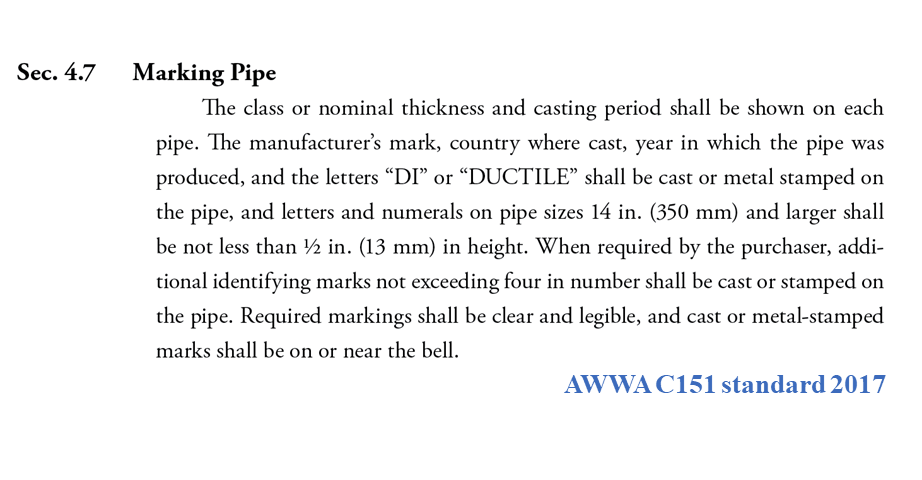This article takes a deeper dive into concepts outlined in the July 2020 entry prepared by my co-worker Gary Gula, How Much Does Ductile Iron Pipe Weigh and Why Does It Matter to You? Specifically, we will focus on the pipe weight itself, answering questions such as:
- From where do these weights originate?
- Why do we show weights on each pipe?
- How trustworthy are these weights as provided?
- What do these weights mean to me, the pipe customer?
History of Ductile Iron Pipe Weights
In the early 1970s, for the most part, Ductile iron pipe (DI pipe) and fittings wholesale replaced the production of its predecessor, gray-iron pipe. Ductile iron is a significant improvement upon the long-proven gray-iron variety. Ductile iron is stronger, more flexible, and more resilient than the gray-iron pipe, even given the thinner pipe walls common to modern DI pipe.
Since the advent of DI pipe, the governing American Water Works Association (AWWA) standards used the pipe's weight as a primary quality assurance (QA) indicator that a pipe was truly manufactured as the wall class it claimed to be. The reasonable presumption, given the consistency of the centrifugal casting process, was that the iron distributed itself evenly throughout the casting machine's travel as the mold rotated at high speed within the machine. This premise is verified for specific lots of pipe via thickness checks along the pipe barrel at a rate and measure "random enough to ensure compliance," which has long been the terminology applied to standardized DI pipe examinations for all aspects of quality assurance.
There are minimum rates of testing prescribed within applicable AWWA standards that must be verified to meet the standard upon any audit or review. Individual manufacturers reserve the right to set their own increased testing rate to ensure compliance for a given period of casting.
After years of discussion among all the producing members and advisors to the AWWA Standards Board, in the 2017 edition of the AWWA C151 Standard, "Ductile-Iron Pipe, Centrifugally Cast," also known as the “the rules of making DI pipe," WEIGHT was removed from the "Marking Pipe" section of the standard. The nominal thickness of the pipe wall has become the primary pass or fail measure.
Another marker towards “we need to check the thicknesses along that pipe barrel” would be if the pipe in question rolls wobbly through the inspection portions of the process. This unbalanced rolling action would suggest the metal on one side of the pipe is thicker than the other and could portend to a thin spot or more somewhere along the barrel. Consistent eyes on the pipe and knowing what to look for are hallmarks of a reliable QA system.
So, Why is the Pipe Weight Still Shown?
In the functional reality of making DI pipe, the pipe's weight is still used by inspectors in the foundry to confirm the assigned wall class. A weight found below the minimum for a particular size and class of pipe remains a primary indicator that thicknesses need to be checked along the barrel to avoid any pipe containing a "thin spot" within the barrel or bell.
Ultrasonic equipment improvements and newer inspection processes, along with far more consistent casting machines themselves, have made this a reliable measure and tells the maker more about iron distribution along the pipe than a single weight value ever could.
While the processes may vary slightly across different manufacturers, it is reliable to state that when a pipe does not achieve the minimum weight for the intended size and class, thickness measurements performed along the full length of the pipe barrel can qualify them to be “down-classed” to a preferred and suitably merchantable (thinner) wall class designation.
This slight variation often winds up being beneficial to the end-user as while the costing of such pipe is based on the "thinner wall class," the actual pipe as-cast tends to be thicker than the nominal wall of that lower wall class assigned to the piece. It is reassuring and important to note that regardless of its assigned wall class, every DI pipe in every available diameter individually receives a 500-psi hydrostatic test in the finishing process at every producing plant. Every pipe. No exceptions.
Given that the weight of each pipe is obtained and recorded by an inline automatic scale during the manufacturing process, and despite since 2017 it not being a value that must be documented to the customer, it remains a professional and informational courtesy to provide it on each pipe, assisting the end-user in aspects of design and selection of machinery to transport, handle, and install the pipe.
While the reach of an excavating machine is generally more important than its carrying capability, it should also be known that the ability to move the dead weight of a single piece of pipe is all the machine needs to do to assemble a DI pipe joint. The weight of the pipe moving across the rubber gasket within the companion bell of another DI pipe compresses the gasket, creating the joint's watertight seal.
Lastly, it is imperative to know that the weight shown on the pipe’s production sticker represents the IRON WEIGHT ONLY for that pipe. Cement lining is not included in the weight on the sticker. It is suggested one should add 5 lbs./ft., 10 lbs./ft., or 15 lbs./ft. for 3-inch to 12-inch pipe, 14- to 24-inch pipe, 30-inch, and larger pipes, respectively, to account for the cement lining weight overall. This addition equates to roughly 100 lbs., 200 lbs., or 300 lbs. of cement lining per piece for both 18- and 20-ft. nominal lengths of pipe for the pipe size ranges described.
Transporting, Lifting, Installing Pipe - The Weight Must be Considered
A forklift or loader, which may be moving more than one pipe at a time from a truck or bundle on the ground, would obviously need to consider the number of pipes involved times the listed weight of each pipe in the interest of safe operations for each lift or transport maneuver.
See these helpful Iron Strong Blogs for more on DI pipe transport, receiving, off-loading, and job site storage tips:
- How Much Ductile Iron Pipe Can Ship on One Truck? by Martin Rodriguez
- Receiving Ductile Iron Pipe – What You Must Know Before You Let the Truck Go by Josh Baker
- Handling Ductile Iron Pipe from Truck to Trench by Dan Flaig
It is important to note that when down-classing occurs, and whether providing actual weights or nominal weights of pipe on the production stickers, it remains the manufacturer's proprietary right to display their choice of a final weight displayed, be it the originally intended class or the lower class assigned.
It is recommended you check with the pipe manufacturer to confirm what selection they utilize in their process. Nonetheless, using a nominal (mid-range) weight for any class is a far better and more reliable estimate of pipe weight than in days past when most manufacturers listed the minimum weight of the size and class.
What Else is the Weight Good For?
When DI pipe are intended for operation in hangers or on supports, such as a pipeline installed along a bridge, the combined weight of the pipe, its cement lining, and any contained fluid must be considered altogether in the design of the hangers or supports. Quite often, the water inside a pipe when full weighs far more than the pipe itself. We will cover these considerations in greater depth in another Iron Strong Blog article coming soon.
Yet for now, as a general example:
- 24-inch class 52 DI pipe weighs conservatively 120 lbs./ft., iron weight only = approximately 2,160 lbs. for an 18-ft. length.
- The cement lining at an estimated 10 lbs./ft. = 180 lbs. for an 18-ft. length.
- A 24-inch class 52 DI pipe holds 25 gal./ft. x 8.33 lbs./gal. = 208 lbs./ft. = 3,750 lbs. for an 18-ft. length = a value nearly 26% greater alone than the pipe and lining weights combined!
- Pipe + lining + water = 6,090 lbs. for an 18-ft. length. This value, plus any safety factor the design engineer or other authority wishes to employ, should be the minimum value used to design any localized hanger or support system.
Conclusion
It is the combination of pipe weights and distributed wall thickness that certify a DI pipe to be the class it is claimed to be. Every production facility relies heavily and equally on both variables to ensure conformance to the required standards and the needs of the customer for long-term service.
The singular thing that truly separates one pipe manufacturer from another is their consistency in and dedication to quality assurance procedures and processes. “Pride and eyes-on” makes everything else work and serve better! Together, Building Iron Strong Utilities for Generations is the sole goal. Please do not hesitate to reach out directly to your local McWane Ductile (MD) Sales Representative, your affiliated Utilities Distributor, or our MD technical staff for additional information. They can assist or put you in touch with the appropriate personnel to provide professional hands-on consult in the field if needed.
















